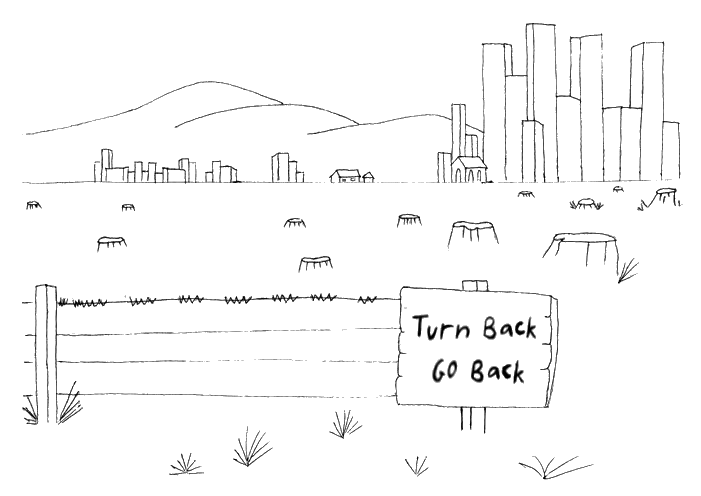

Environment
Landcare and the Murray Darling Basin > Saving the Murray > Life & Death of the BillabongUnderstanding Environmental Economics > How to be Green
LandCare
and the Murray-Darling Basin
(30 June 2003)
[Christom]
What is LandCare?
LandCare is the general term used for society as a whole working together to care for the land. The term formally became recognised in the late 80’s as governments, businesses and the wider community saw the need to take action in regards to the environment. This action included the formation of a number of groups and the development of a number of projects. Land care involves tree planting, revegetaion to deal with salinity, weed control, wildlife rescue, dealing with feral animals and the protection and management of waterways and dryland in general.The Murray Darling Basin
There are a number of different issues in regards to land care but there are probably none as important as the preservation of the Murray-Darling Basin. This is the term given to the land and water catchment areas associated with Australia’s three longest rivers. The Darling River (2740km long) the River Murray (2530km long) and the Murrumbidgee River (1690km long). The combined dryland and catchment area is about one seventh of Australia’s total landmass.The Basin produces about one third of Australia’s food supply and the total value of the irrigated production from the Basin is worth around $3-4 billion before this value is multiplied by four again after processing. It accounts for just under three quarters of Australia’s total irrigated crops and pastures. The main industries include horticulture (particularly viticulture), cotton, rice and dairy. The significance of these river systems and surrounding drylands that effect the Basin is unparalleled throughout Australia. Some have described the Murray-Darling Basin as the lifeblood of this Great South Land.
The continual degradation of the Murray river in recent years has caused it to become one of our most significant National landcare issues; the other of course is our salinity problems which are also interwoven with the river. The Murray-Darling river system extends over four states and is Australia's largest river system. The reason for it being such a well known issue is because of the very nature of our nation and its vulnerability in regards to water. Mitch O'Toole sums up how critical our water supplies are to our dry and barren land with this quote:
Australia is the driest inhabited continent. The average annual rainfall over the continent is only 465 milliliters, and 87 per cent of this water dries off. Groundwater is the only water source for almost 60 per cent of the country, and the main source for a further 20 per cent. Most Australians live in cities, which causes a basic problem. Australians are concentrated in large groups, and those groups need water. Our regular droughts merely underline this fundamental reality. Australian rivers are small by world standards, our mountains are low, there is only one major reservoir of snow and that is seasonal. The overall flatness of the continent makes places for dams hard to find and the hot dry climate makes water storage less efficient once the dams are built. Much of the stored water evaporates.
Q1a)
What is a Billabong?
A billabong is a body of still water that exists separate from the main body of water that is running. They are remaining remnants of a river once floodwaters have resided.
A billabong is a body of still water that exists separate from the main body of water that is running. They are remaining remnants of a river once floodwaters have resided.
Q1b)
In what ways are billabong numbers declining?
Billabong numbers are declining because they are drying up, being drained or getting filled in by bulldozers for development. Some are even being abused by being used as private rubbish dumps. They are also being drained because of irrigation and the construction of dams and weirs.
Billabong numbers are declining because they are drying up, being drained or getting filled in by bulldozers for development. Some are even being abused by being used as private rubbish dumps. They are also being drained because of irrigation and the construction of dams and weirs.
. . .
Q3)
How is the interdependence of billabong and river illustrated by the decline in Murray cod?
A significant reason why the Murray cod has diminished is because the young cod have been starved of the abundant microscopic food sources available in the billabong. Floods played the part of linking these food providers to the main river to enable the cod to spawn in these areas. Now young cod are left in the nutrient diminished main stream, fighting for their survival.
A significant reason why the Murray cod has diminished is because the young cod have been starved of the abundant microscopic food sources available in the billabong. Floods played the part of linking these food providers to the main river to enable the cod to spawn in these areas. Now young cod are left in the nutrient diminished main stream, fighting for their survival.
Understanding Environmental Economics
(Melbourne, Australia, Longman Cheshire Pty Ltd, 1992)
[Bridget Sant]
1
Environmental economics is concerned with the whole range of environmental issues. These can be divided into three categories:
resource depletion, residual generation and ecosystem destruction. Resource depletion refers to the decrease in quantity and quality of available resources,
both those which are thought of as renewable, such as soil and water, as well as those that are non-renewable, such as fossil fuels and metals.
Residual generation is simply the accumulation of gaseous, liquid and solid wastes. Ecosystem destruction is the loss of natural habitat,
mainly through land transformation, reducing biological diversity and the availability of natural environments.
257
Making the Connections
When ecologist Barry Commoner wrote The Closing Circle (one of the classics of green thinking) in 1971, he included a very simple formulation of the basic ‘laws of ecology’. They are so clear and straightforward that it is well worth memorising them:
When ecologist Barry Commoner wrote The Closing Circle (one of the classics of green thinking) in 1971, he included a very simple formulation of the basic ‘laws of ecology’. They are so clear and straightforward that it is well worth memorising them:
- Everything must go somewhere.
- Nature knows best.
- There's no such thing as a free lunch.
- Everything is connected with everything else.
258
repercussions. Our planet is finite; a closed system’. Wherever we put our ‘rubbish’ it will continue to haunt us,
just like the boxes of junk under the stairs.
The second law warns us that we thwart and destroy nature at our peril,
and that nature has been evolving excellent life-support systems for millions of years longer than human beings have.
The third law makes it clear that everything we consume has an environmental and social cost.
Though we might like to imagine that the luxuries of life simply appear before us without any provenance, it is a costly delusion.
Up to now most people in Australia have been able to consume as they do at the expense of ignoring the continuing decline of their own health,
that of their surroundings, and the chronic ill health of the Third World. Today, however, the legacy of profligacy and pollution is hard to ignore.
Of the four laws, the last is the key and the one that helps us to understand the others. Everything is connected to everything else.
This is the philosophy and practice of holism, or holistic thinking, which says that you can never make complete sense of anything
unless you take into account all its circumstances and complex interconnections.

